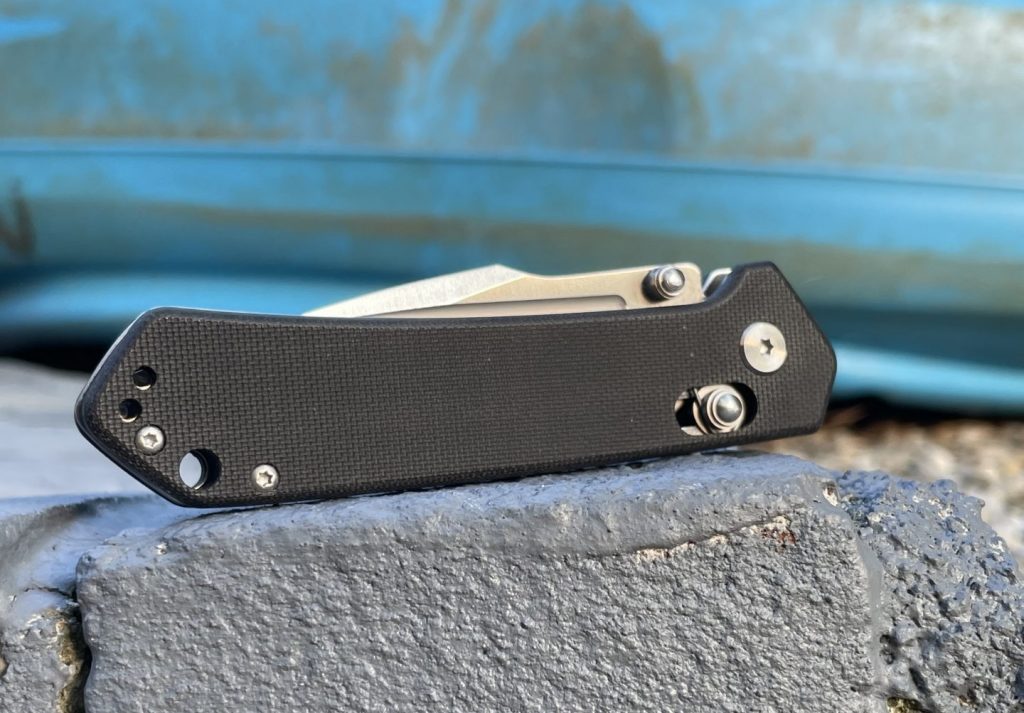
The Schrade Divergent actually caught my attention quite some time back. I don’t even remember where I first saw it, it must have been on Instagram or one of Schrades personalized marketing feeds.
The thing that drew me to it wasn’t the size, or profile – these are both pretty nondescript. It was that little bar high on the handle near the shoulder of the blade by the pivot point. That little bar is a dead giveaway for an AXIS-style lock – just like what Benchmade uses on many of their folding knives.
Benchmade calls it an AXIS lock; Schrade calls it a Pivot lock; but they both work in identical ways, and the lock is supposed to be very, very strong.
Plus, Schrade’s a decent knife company. I’m not sure if anyone thinks they make super-premium knives but their prices are pretty good and if nothing else, the tools they make are bombproof. So I figured it was worth the gamble. I just needed to wait till I could get a good price on it.
Interestingly enough, Schrade has been blowing out some of their inventory on their actual website (Schrade.com) and I picked up a Schrade Divergent from them. Actually, I got two, and paid less than $23 dollars for each. Considering that there are more expensive tolls, I’d call that a steal.
Here’s what the knife offers.
Schrade Divergent Specs
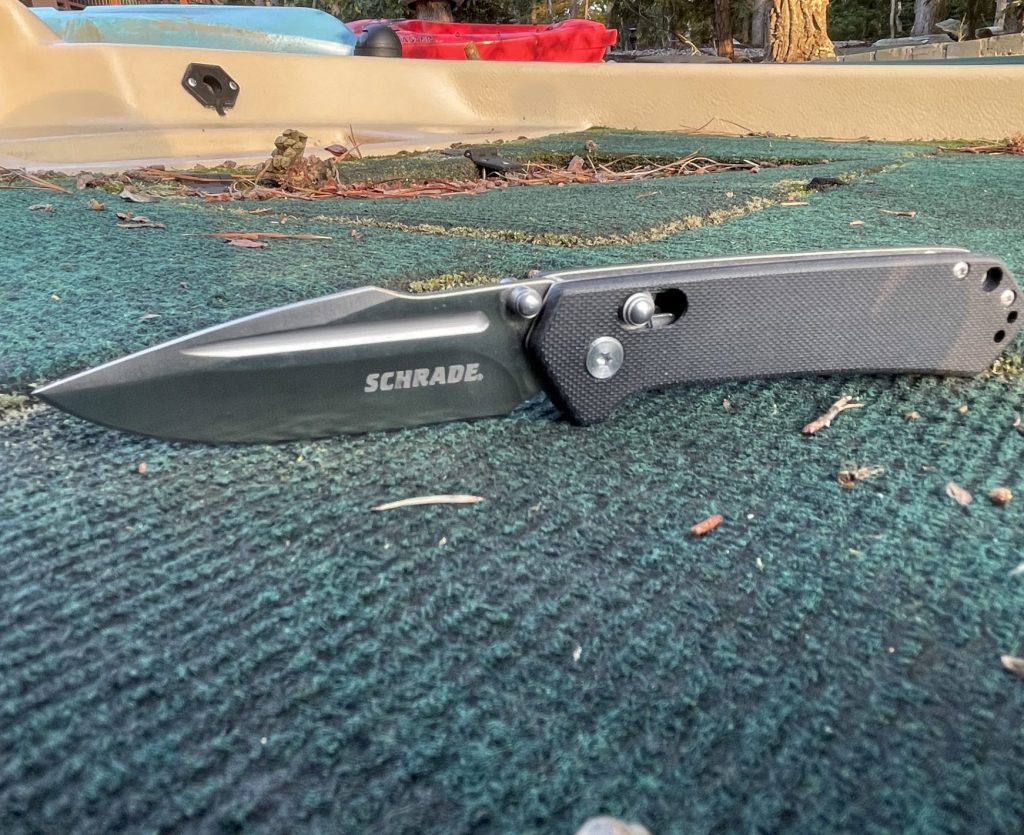
The Schrade Divergent, except for the conspicuously different lock type, looks the part of just any other folding knife on the market. It’s boxy, square and black.
The Schrade Divergent weighs 3oz even. Open, it is 7.50” and it has a 3.25” blade with 3” of edge. Blade thickness is .10”, profile is a sort of modified clip point (it could be called a drop point) with a thumb ramp along the spine, without jimping. Grind is hollow but nearly flat.
The scales are G10 and the blade is made of AUS-8 stainless steel. Deployment is via ambidextrous thumb studs and around a bearing pivot system. The lock is a type of bar lock that Schrade calls a “Pivot” lock.
Carry is tip-up via a reversible pocket clip; there is a lanyard hole through the scales.
Now let’s get into the meat of this knife.
Steel and Blade Profile

The 3” blade is made of AUS-8 stainless steel and features either a modified clip point or a drop point style configuration. There is a single round fuller high on the blade near the spine, as well as a thumb ramp. The blade lacks jimping, and the grind is hollow.
Not sure where to start here because there is a lot to say about the blade design, steel and profile, so let’s start with the steel.
This is AUS-8 steel, the same thing that OKC uses in the RAT I and II. It’s a good stainless alloy; the real players in this alloy are carbon at .75% and chromium at 1.5%. There’s also a smidge of manganese, vanadium, and a few other trace elements. Both manganese and vanadium are present at les than 1% but they do increase the toughness and wear resistance of this alloy.
Anyway, before I get away from myself talking about steel chemistry, what I can say about AUS-8 is that it has serious potential. It’s very rust resistant and pretty tough, and even though it gets dull relatively quickly, if you have skill with a stone you can shave with it. It can take a serious edge.
There’s a drawback here, though. Whether intentionally or not, there’s a slight recurve in the blade by the handle. You can’t see it in pictures; it’s so gentle that you’d need to look at the blade point-on to notice it.

It wouldn’t be a huge deal if the knife came from the factory sharp, but the factory edge on both of the Divergent models I bought was pretty bad. Like, not atrocious but there was no way in hell I was going to carry that thing in my pocket before I put my own edge on it. This is where the problem of the recurve arises.
The recurve makes it very difficult to get an edge on the first inch and a half of the blade using a flat stone. What I had to do was basically grind the recurve out of the edge, which was a tough process. After that, it took a great edge, so I can’t complain too much, but it was extra work for me.
I have to admit, I don’t love the aesthetics of the blade. They’re a bit flashy for me. I prefer something, shall we say, uglier, like the OKC RAT II. This knife, with its fuller and thumb ramp, catches the attention. I tend to like plain tools.
There is a practical reason I brought this up. The thumb ramp looks like it’s there for style, but it isn’t. It’s actually really, really ergonomic, as you can see in the picture below.

The lack of jimping costs this knife a point or two on control, but when you choke up on the blade as you can see me doing in the picture above, you get a lot of that back. So it looks like a “cool” feature, but actually it improves the handling of the knife substantially.
Now let me say what I have to say about the fuller. I’m still not sold. There’s literally no purpose for it in a knife of this size. Typically, a fuller is included for one of two reasons. Either it strengthens and stiffens the blade, by introducing a new axis of flexion, or it lightens the blade, by creating a void in the overall mass. Sometimes it accomplishes both at once.
In a knife of this size, a fuller is entirely pointless. All it does is create more surface area to oil and keep clean, which makes more work for the person carrying the knife. Is it terrible? Do I absolutely hate it? No, but I wish it wasn’t there. It’s all talk and can’t back itself up. It’s not like a 3” blade needs support or we’re saving any serious weight by forgoing that, what, .02 ounces of steel. Next time I’d like to see a knife like this without it.
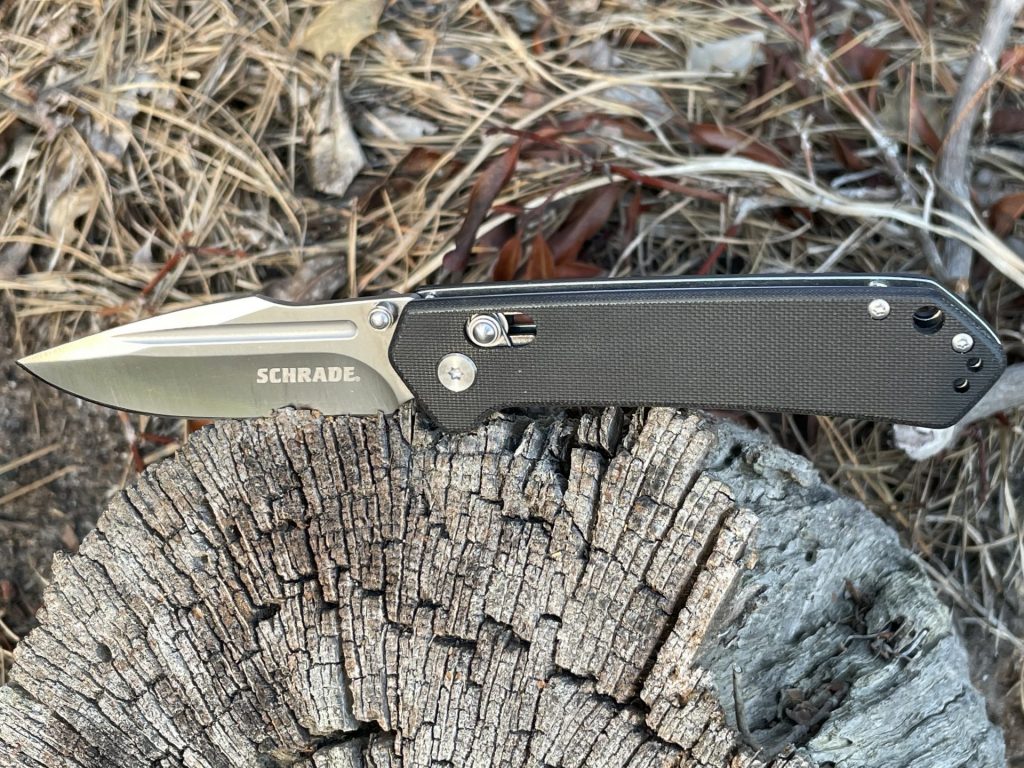
Other than that, the blade is perfectly useful. The hollow grind is just alright. On the one hand, it’ll make the blade easier to touch up down the line, and hollow grinds tend to do well with slicing through meat, but I don’t see myself using this knife as a hunting or fishing knife, except incidentally. A flat grind would probably be more utilitarian, but that’s a matter of preference. All in all, I have nothing against hollow grinds. After all, I love Buck. I’d be a hypocrite if I did.
In terms of blade length and size, this knife is just about as good as it gets. As I stated, I love my CJRB Maileah, but that knife is a little small. The Schrade Divergent is more in line with what I consider optimally sized for EDC.
Without boring you with details, the Divergent’s blade is good for a lot. Since it’s corrosion resistant, I wouldn’t have too many qualms (if any at all, really) about bringing it on the lake or the bay. It’s big enough to carve feathersticks and camp tools or cut up bait, but small enough that it rides comfortably in a pocket.
Plus, this size and shape are totally nondescript. It’s not overspecialized. It’s just a 3” drop point/clip point hybrid. It works.
Handle Material and Ergonomics

I wish I could say something very positive or very negative about the handle material and ergonomics but I just can’t. It just exists. I do like this knife, but this is about the most generic handle assembly and profile I’ve ever seen in a knife, anywhere.
I don’t know how I’d describe this handle profile except that it’s sort of coffin shaped, although not really. It’s kind of boxy, actually, with a bit of a projection toward the blade that serves in lieu of a proper choil or crossguard to keep your hand from sliding forward.
There are some good things I can say about the handle and scales, though. One, the Schrade Divergent uses G10 scales. I have plenty good to say about G10. It’s extremely durable, will not absorb water or oil, is basically impervious to UV, is really strong, and very resistant to shattering or cracking. So it’s like weatherproof, waterproof, in a sense, everything proof. It’s so tough you could use it as a hammer, seriously. It also has a nice tread which gives you a good grip.
The handle’s ergonomics are also not uncomfortable, which is a credit to the knife. Looking at the weird corners and angles you might expect some hot spots, but there really aren’t. Also, the scales and liners are pretty well machined and beveled, so there aren’t any sharp edges.
Also, the width of the handle, although it’s sort of clunky, makes it very difficult to lose control of the knife while twisting or prying. Not that you should do that with a folder, but if you do, you’ll have a good grip on the Divergent.
Since it’s sort of big and blocky, the handle gives you plenty of purchase. Unlike smaller knives I’ve reviewed so far, this thing fills your grip. It’s comfort in a saber grip, hammer grip, reverse grip, pinch grip, you name it. There are many other more uncomfortable folders out there.

So while the handle doesn’t really win any records for anything, it’s really not bad. It’s just not a banner design.
About the Schrade Pivot Lock

In the spirit of publishing a fully candid Schrade Divergent review, I’d be lying if I said there was honestly any other factor that sold me on this knife. I legitimately wanted to buy one because I have no other folders with bar locks and this is by far the most affordable option on the market.
Plus, with the AUS-8 blade and solid construction, I thought it couldn’t be a total miss. There are a lot of worse things I could do with something like $20.
So anyway, to keep it straightforward, I really like this lock. I’m not saying I’m going to ditch my liner locks and lock backs, but this is a refreshing take on folding knife locks.
If you’re not familiar with bar style locks, also known as AXIS-style locks, the mechanism of operation is actually fairly straightforward.
Behind the blade, there is a cylindrical bar of steel. This blade rests in a cut out that lies between the scales and the liner of the knife. Inside of the liner, there is a recess that contains a spring. I’m not sure exactly what the shape of the spring is that Schrade uses, but it’s probably a V, a U, or an Omega (Ω) shaped spring.
When the blade is closed, the spring tension pushes against the bar which in turn pushes against the shoulder of the blade. Opening the blade compresses the spring, which pushes the bar backward along the channel that is cut into the liners and scales.
When the blade is opened fully, the pressure from the spring forces the bar forward in the channel, right up against a notch cut into the back of the blade blank. This locks the blade open very securely. Besides the fact that it ranks high on cool factor, there are a lot of advantages of this lock style, and not many disadvantages.
The first is that it is very strong. Putting pressure on the blade in any direction is unlikely to cause a failure of the bar itself, which is a very thick piece of steel. The spring could fail, but that is likely only to occur by opening and closing the blade. When in use, there’s nothing you can really do to strain the spring, only the bar.
This is very different from a liner lock, where pressure on the spine of the blade can actually deform the lock and cause the blade to close. Not that I’m proud of it, but I’ve actually caused several liner lock failures in a variety of different knives over the years. Force or pressure on the spine makes the lock fold – literally. Now, I’ve been lucky, and in none of these instances did the blade actually close on my hand – but again, that was luck.
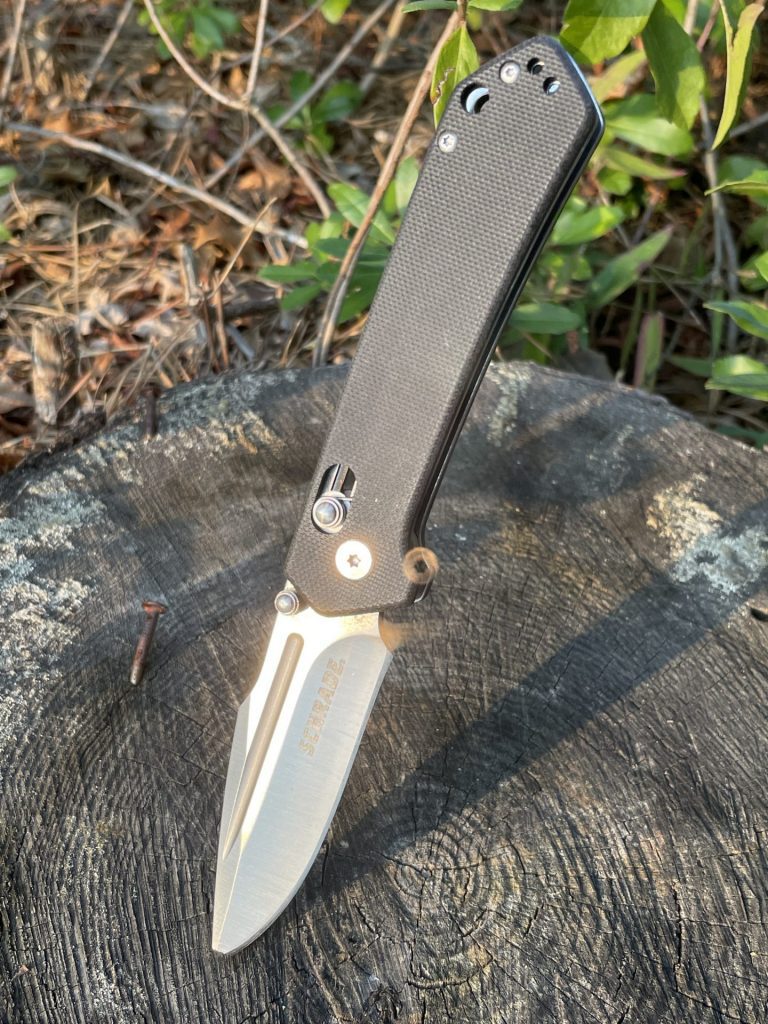
Even if the spring did fail while using the blade, the bar would still be in place. You would have to consciously disengage the bar for the knife to close. Other than that, there’s nowhere for the bar to go. You can’t force it directly through the liner and scales. So in short, this is a very strong, very secure lock type.
Another advantage this lock style has over alternatives like liner locks is that while closing the blade, your fingers can remain fully out of the way of the path of the closing blade. You can love liner locks and frame locks, but for better or worse, when disengaging them, your fingers are in the way of an edge, and edges bite.
Also, bar locks like this one are truly ambidextrous. You can get used to closing a liner lock or a frame lock with your non-dominant hand, but it’s never quite easy. Since the bar is accessible from both sides of the grip, it’s easier to disengage.
There’s an even more important advantage. It is all too easy, disturbingly easy, I’d say, to accidentally disengage a liner lock while exerting force towards the spine of the knife, or when twisting. There have been some instances where I have accidentally disengaged liner locks and the blade did unfortunately close on my hands. Once I was using the tip of a liner lock knife to pry open a knot in a dock line; I should have used a spike, but I wasn’t, and when the lock failed, the blade closed on my hands. It wasn’t fun.
That can’t happen with a bar lock. For the most part, when you’re using the knife, your hands aren’t in contact with the bar. It’s an added layer of security.
Also, in addition to making the knife easier to close, the bar lock also makes the knife a lot more fun to open. You can flick this thing open using the thumb studs, but it also can be whipped open by decompressing the bar lock and flipping the wrist. It’s entertaining and makes this a fairly fidgety knife. It also means this knife can be easily deployed and closed and stowed with just one hand. There’s never a situation where you’d actually need two to use it, which is nice.
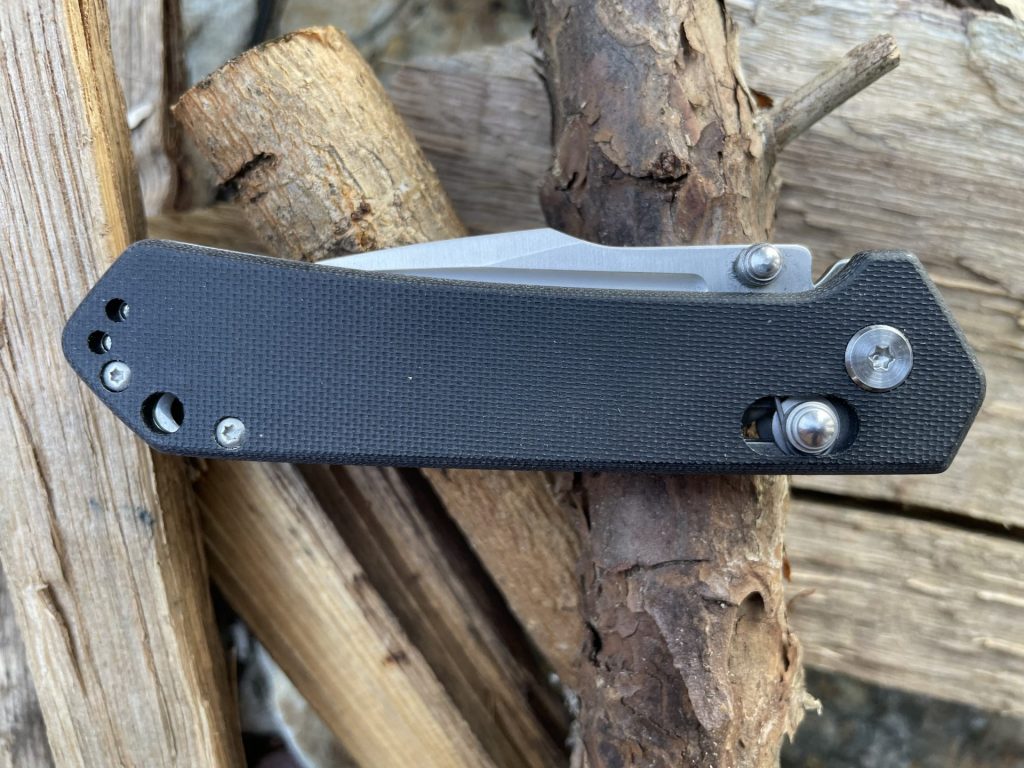
Should You Get a Schrade Divergent?
If you haven’t gotten the impression yet, I might as well just tell you plainly. I don’t love the blade profile or the overall design of the knife. It’s totally serviceable and it’s a good design, but that’s not why I decided to get it.
What sold me on this knife was the lock type, and as far as I know, it’s the only one of this type in this price range. So if you’re interested in getting a folding knife with a bar lock and don’t want to shell out a hundred or two on a Benchmade, then visit Schrade’s website and get a Divergent or a few of them. At the time of this publication, It’s still less than $23 and Schrade offered me free shipping.
~The Eclectic Outfitter